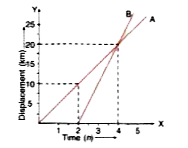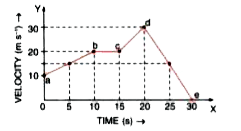Complete Solutions to EXAMPLE of chapter MOTION IN ONE DIMENSION of Class 9 book with complete answers and questions
| Class 9 | PHYSICS |
| Chapter | MOTION IN ONE DIMENSION |
| SELINA PUBLICATION | EXAMPLE |
| Number Of Questions | 25 |
| Academic Year | 2023-24 |
Select the scalars and vectors from the following: Velocity, distance, acceleration, work, mass, retardation.
View SolutionExpress the speed 36 km `h^(-1)` in m `s^(-1)` .
View SolutionFind the distance travelled by a body in 5 minutes if it travels with a uniform speed of 20 m `s^(-1)` .
View SolutionA train moving with uniform speed covers a distance of 120 m in 2 s. Calculate : (i) the speed of the train, (ii) the time it will take to cover 240 m.
View SolutionA body rises vertically up to a height of 125 m in 5 s and then comes back at the point of projection. Find: (i) the total distance travelled, (ii) the displacement, (iii) the average speed and (iv) the average velocity of the body.
View SolutionA train first travels for 30 min with a velocity 30 km `h^(-1)` and then for 40 min with a velocity 40 km `h^(-1)` in the same direction, Calculate : (i) the total distance travelled, (ii) the average velocity of the train.
View SolutionA car travels a distance 50 km with a velocity 25 km `h^(-1)` and then 60 km with a velocity 20 km `h^(-1)` in the same direction. Calculate : (i) the total time of journey and (ii) the average velocity of the car.
View SolutionThe velocity of an object increases at a constant rate from 20 m `s^(-1)` to 50 m `s^(-1)` in 10 s. Find the acceleration.
View SolutionA pebble thrown vertically upwards with an initial velocity 50 m `s^(-1)` comes to a stop in 5 s. Find the retardation.
View SolutionThe table below shows the distance in cm, travelled by the objects A, B and C during each second. (i) Which object is moving with constant speed ?
Give a reason for your answer.
(ii) Which object is moving with a constant acceleration? Give a reason.
(iii) Which object is moving with irregular acceleration?

View SolutionThe following table represents the distance of a car at different instants in a fixed direction.

(a) Draw a displacement-time graph and with its help, find whether the motion of the car is uniform or non-uniform?
(b) Use graph to calculate :
(i) the velocity of car (ii) the displacement of car at t = 2.5 s and t = 4.5 s.
View SolutionFig 2.26 shows the displacement-time graph for the motion of two boys A and B along a straight road in the same direction. Answer the following:
(i) When did B start after A ?
(ii) How far away was A from B when B started?
(iii) Which of the two has greater velocity ?
(iv) When and where did B overtake A ?

View SolutionA car travels with a uniform velocity of 20 m `s^(-1)` for 5 s. The brakes are then applied and the car is uniformly retarded. It comes to rest in further 8 s. Draw a graph of velocity against time. Use this graph to find :
(i) the distance travelled in first 5 s,
(ii) the distance travelled after the brakes are applied,
(iii) total distance travelled, and
(iv) acceleration during the first 5 s and last 8 s.
View SolutionA train starts from rest and accelerates uniformly at 100 m `"minute"^(-2)` for 10 minutes. Find the velocity acquired by the train. It then maintains a constant velocity for 20 minutes. The brakes are then applied and the train is uniformly retarded. It comes to rest in 5 minutes. Draw a velocity-time graph and use it to find :
(i) the retardation in the last 5 minutes,
(ii) total distance travelled, and
(iii) the average velocity of the train.
View SolutionA stone is thrown vertically upwards with an initial velocity of 40 m `s^(-1)`. Taking g = 10 m `s^(-2)`, draw the velocity-time graph of the motion of stone till it comes back on the ground.
(i) Use graph to find the maximum height reached by the stone. (ii) What is the net displacement and total distance covered by the stone ?
View SolutionA car starting from rest, accelerates at a rate of 2 m `s^(-2)` for 5 s. For this journey, (a) draw the velocity-time graph (b) draw the displacementtime graph using the velocity-time graph in part (a).
View SolutionThe following table represents the velocity of a moving body at different instants of time. Times (s) 0 5 10 15 20 25 30 Velocity (ms −1 ) 10 15 20 20 30 15 0 The velocity-time graph is as shown in figure.

For which interval of time the body has a uniform motion ? Find the velocity in this time interval ? 204500 Expand-image
View SolutionA car acquires a velocity of 72 km `h^(-1)` In 10 s starting from rest. Calculate :
(i) the acceleration,
(ii) the average velocity, and
(iii) the distance travelled in this time.
View SolutionA ball is initially moving with a velocity `0.5 m s^(-1)` ms. Its velocity decreases at a rate of 0.05 m `s^(-2)`. (a) How much time will it take to stop ? (b) How much distance will the ball travel before it stops ?
View SolutionA body initially at rest travels a distance 100 m in 5 s with a constant acceleration. Calculate : (i) the acceleration, and (ii) the final velocity at the end of 5 S.
View SolutionA car initially at rest starts moving with a constant acceleration of 0.5 m `s^(-2)` and travels a distance of 25 m. Find : (i) its final velocity and (ii) the time taken.
View SolutionA body moving with uniform acceleration travels 84 m in the first 6 s and 180 m in the next 5 s. Find : (a) the initial velocity, and (b) the acceleration of the body.
View SolutionA body with an initial velocity of 18 km `h^(-1)` accelerates uniformly at the rate of 9 cm `s^(-2)` over a distance of 200 m. Calculate :
(i) the acceleration in m `s^(-2)`
(ii) its final velocity in m `s^(-1)`.
View SolutionA particle initially at rest, moves with an acceleration 5 m `s^(-2)` for 5 s. Find the distance travelled in (a) 4 s, (b) 5 s and (c) 5th second.
View SolutionA particle starts to move in a straight line from a point with velocity 10 m `s^(-1)` and acceleration - 2.0 `m s^(-2)`. Find the position and velocity of the particle at (i) t = 5 s, (ii) t' = 10 s.
View Solution
EXAMPLE questions and complete solutions for chapter MOTION IN ONE DIMENSION of ICSE of Class 9